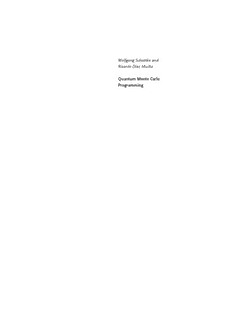Table Of ContentWolfgangSchattkeand
RicardoDíezMuiño
QuantumMonteCarlo
Programming
RelatedTitles
Waser,R.(ed.) Allinger,N.L.
Nanoelectronicsand Molecular Structure
InformationTechnology UnderstandingStericandElectronic
AdvancedElectronicMaterialsand EffectsfromMolecularMechanics
NovelDevices
2010
ISBN:978-0-470-19557-4
2012
ISBN:978-3-527-40927-3
Owens,F.J.,Poole,Jr.,C.P.
Reimers,J.R.
The Physicsand Chemistryof
Computational Methods for Nanosolids
LargeSystems
2008
ElectronicStructureApproachesfor
ISBN:978-0-470-06740-6
BiotechnologyandNanotechnology
2011
ISBN:978-0-470-48788-4 Reinhard,P.-G.,Suraud,E.
Introduction toCluster
Dynamics
Alkauskas,A.,Deák,P.,Neugebauer,J.,
Pasquarello,A.,VandeWalle,C.G.(eds.)
2004
Advanced Calculations for ISBN:978-3-527-40345-5
DefectsinMaterials
ElectronicStructureMethods
Landau,R.H.,Páez,M.J.
2011
Computational Physics
ISBN:978-3-527-41024-8
ProblemSolvingwithComputers
1997
Kroese,D.P.,Taimre,T.,Botev,Z.I.
ISBN:978-0-471-11590-8
Handbook of Monte Carlo
Methods
2011
ISBN:978-0-470-17793-8
Wolfgang Schattke and Ricardo Díez Muiño
Quantum Monte Carlo Programming
for Atoms,Molecules,Clusters,and Solids
TheAuthors AllbookspublishedbyWiley-VCHarecarefully
produced.Nevertheless,authors,editors,and
Prof.WolfgangSchattke publisherdonotwarranttheinformation
InstituteofTheoreticalPhysicsandAstrophysics containedinthesebooks,includingthisbook,to
Christian-Albrechts-UniversityKiel befreeoferrors.Readersareadvisedtokeepin
Leibnizstr.15 mindthatstatements,data,illustrations,
24118Kiel proceduraldetailsorotheritemsmay
inadvertentlybeinaccurate.
and
LibraryofCongressCardNo.:
IkerbasqueFoundation/DonostiaInternational appliedfor
PhysicsCenter
BritishLibraryCataloguing-in-PublicationData:
P.ManueldeLardizabal4
Acataloguerecordforthisbookisavailable
20018Donostia–SanSebastián
fromtheBritishLibrary.
Spain
Bibliographicinformationpublishedbythe
Dr.RicardoDíezMuiño
DeutscheNationalbibliothek
CentrodeFísicadeMaterialesCSIC-UPV/EHU
TheDeutscheNationalbibliothekliststhis
and publicationintheDeutscheNationalbibliografie;
detailedbibliographicdataareavailableonthe
DonostiaIntern.PhysicsCente Internetathttp://dnb.d-nb.de.
P.ManueldeLardizabal4
20018Donostia–SanSebastian ©2013WILEY-VCHVerlagGmbH&Co.KGaA,
Spain Boschstr.12,69469Weinheim,Germany
Allrightsreserved(includingthoseoftranslation
intootherlanguages).Nopartofthisbookmay
bereproducedinanyform–byphotoprinting,
microfilm,oranyothermeans–nortransmitted
ortranslatedintoamachinelanguagewithout
writtenpermissionfromthepublishers.Regis-
terednames,trademarks,etc.usedinthisbook,
evenwhennotspecificallymarkedassuch,are
nottobeconsideredunprotectedbylaw.
PrintISBN 978-3-527-40851-1
ePDFISBN 978-3-527-67574-6
ePubISBN 978-3-527-67532-6
mobiISBN 978-3-527-67531-9
Composition le-texpublishingservicesGmbH,
Leipzig
PrintingandBinding MarkonoPrintMedia
PteLtd,Singapore
CoverDesign Adam-Design,Weinheim
PrintedinSingapore
Printedonacid-freepaper
V
Contents
Preface IX
1 AFirstMonteCarloExample 1
1.1 EnergyofInteractingClassicalGas 1
1.1.1 ClassicalMany-ParticleStatisticsandSomeThermodynamics 2
1.1.2 HowtoSampletheParticleDensity? 18
2 VariationalQuantumMonteCarloforaOne-ElectronSystem 23
3 Two Electrons with Two Adiabatically Decoupled Nuclei:
HydrogenMolecule 39
3.1 TheoreticalDescriptionoftheSystem 39
3.2 NumericalResultsofModerateAccuracy 42
3.3 ControllingtheAccuracy 46
3.4 DetailsofNumericalProgram 53
4 ThreeElectrons:LithiumAtom 61
4.1 MoreElectrons,MoreProblems:ParticleandSpinSymmetry 63
4.1.1 AntisymmetryandDecompositionoftheMany-BodyWaveFunction 63
4.1.2 Three-ElectronWaveFunction 65
4.1.3 GeneralWaveFunction 67
4.1.4 RelaxingSymmetryofTotalSpin 70
4.2 ElectronOrbitalsfortheSlaterDeterminant 71
4.3 SlaterDeterminants:EvaluationandUpdate 76
4.4 SomeImportantObservablesinAtoms? 82
4.4.1 TheModule“observables” 87
4.5 StatisticalAccuracy 91
4.6 GroundStateResults 93
4.6.1 ResultsforLithiumAtom 93
4.6.2 CodeofMainProgram,ModulesofVariables,ofStatistic,ofJastrow
Factor,andofOutput 103
4.7 Optimization? 115
5 Many-ElectronConfinedSystems 121
5.1 ModelSystemswithFewElectrons 121
VI Contents
5.2 OrthorhombicQuantumDot 122
5.2.1 ConfinedSingle-ParticleWaveFunctions 122
5.2.2 DetailsofProgram 123
5.2.3 EnergyandRadialDensity 125
5.2.4 Pair-CorrelationFunction 131
5.2.5 ProgramofthePair-CorrelationFunction 134
5.3 SphericalQuantumDot 136
5.3.1 FundamentalsofDFT 137
5.3.2 DFTCalculationoftheJelliumCluster:Methodology 138
5.3.3 QMCCalculationoftheJelliumCluster:Methodology 140
5.3.4 QMCCodefortheCalculationofJelliumClusters 141
5.3.5 Comparison between DFT and QMC Calculations of Jellium
Clusters 142
6 Many-ElectronAtomicAggregates:LithiumCluster 147
6.1 ClustersandNanophysics 147
6.2 CubicBCCArrangementofLithiumAtoms 150
6.2.1 StructureoftheMainProgram 150
6.2.2 Single-ElectronWaveFunctionsandStructureoftheDeterminant 150
6.2.3 GeometricSettingoftheCluster 153
6.2.4 ChangesintheProgram 156
6.3 TheCluster:IntermediatebetweenAtomandSolid 163
6.3.1 1(cid:2)1(cid:2)1Cluster:Li 164
2
6.3.2 2(cid:2)2(cid:2)2Cluster 167
6.3.3 3(cid:2)3(cid:2)3Cluster 172
6.3.4 4(cid:2)4(cid:2)4Cluster 174
6.3.5 ClusterSize 178
7 InfiniteNumberofElectrons:LithiumSolid 181
7.1 InfiniteLattice 183
7.1.1 TheLattices 183
7.1.2 StructureoftheElectrostaticPotential 186
7.1.3 EwaldSummationandTabulation 191
7.1.4 Finite-SizeEffects 204
7.2 WaveFunction 208
7.2.1 LinearCombinationofAtomicOrbitals 208
7.2.2 PlaneWaves 210
7.3 JastrowFactor 212
7.3.1 StandardChoice 213
7.3.2 PrincipalIdeasandExtensions 215
7.4 Resultsforthe3(cid:2)3(cid:2)3and4(cid:2)4(cid:2)4SuperlatticeSolid 216
8 DiffusionQuantumMonteCarlo(DQMC) 223
8.1 TowardsaFirstDQMCProgram 224
8.1.1 RelatingSchrödingerEquationtoDiffusion 224
8.1.2 GenerateGaussianRandomNumbers 228
Contents VII
8.1.3 Application 229
8.1.3.1 HarmonicOscillator 229
8.2 Conclusion 235
9 Epilogue 237
Appendix 239
A.1 TheInteractingClassicalGas:HighTemperatureAsymptotics 239
A.2 PseudorandomNumberGenerators 241
A.3 SomeGeneralizationoftheJastrowFactor 247
A.4 SeriesExpansion 249
A.5 WaveFunctionSymmetryandSpin 257
A.5.1 FourElectrons 257
A.6 InfiniteLattice:EwaldSummation 259
A.7 LatticeSums:Calculation 263
References 269
Index 273
IX
Preface
Thereadermightbeinclinednottoreadtheprefacewhenstartingwiththebook,
butrather atalater timewhenlazinessorleisureleavestimeforit.Intheworst
case, thereader might come back to the preface angered by some lack of under-
standingor,quitetheopposite,angeredbyreadingsomeundergraduatesimplistic
explanations.Byconsultingthepreface,thereaderisaskingtheauthorsabouttheir
goalsinwritingthebook.
Themaingoalisdeclaredbythebook’stitle,neverthelesswithsomerestrictions
inmind.
Thefollowingpublicationissettledsomewherebetween atextbookandacom-
putercodemanual.Itslevelisperhapstoospecializedforatextbookandtoobroad
foramanual.Apositivecommentwouldbethatitscontentincludesratherprac-
tical adviceon what isusuallydescribed in atheoretical textbook, as well as pre-
senting in more detail the physical understandingof what the manual of a code
promisesasaresult.Danglingbetweenthesetwoextremestheauthorscouldnot
decidewheretoplacethebookexactly,sotheydecidedtotaketheriskofsharing
thecommongroundinboth.
Of course, one purpose was to make it more reader-friendly than a scientific
paper,orareviewarticle.However,reviewssuchasthatofFoulkes,Mitas,Needs,
andRajagopalforexample,represent invaluablesourcesforextendedstudies[1].
Thepathtofulfillingthepurposeofa“friendly”bookwasledonlybytheauthors’
own experience and will differ from that of others. In other words, neither the
authors attended courses on “How to Write Pedagogically Good Books” nor did
theyreadsuchliterature.
Of course, the reader does not expect a manual coming with a scientific code
which reduces to “read the input file explanations and then go on.” Therefore,
insteadofpresentingjustonecodethatcouldcoverthegeneralfield,theauthors
decidedtobreakuptheprogramintopieces,eachofthemdevotedtooneofafew
leadingexamples.
Apedagogic,buttimeandspace-consumingpossibilitywouldhavebeentode-
velopthecodesstepbystep,toletthereaderrunintothemanytrapsofprogram-
mingerrorswithexercisesandsolutions.Thatcouldfillmanyvolumes.Wetried
nottoexpandthevolumebeyondacceptablelimits,buttokeepenoughmaterialso
X Preface
thatthereader couldstart anddevelopfromithisorherownspecificprograms.
Therefore,wegaveuponthetextbookidea.
Attheveryfirstconceptofthisbookwethoughtofpresentingthecodecollected
fromthePhDthesesofEcksteinandBahnsen,whocompletedtheirworkwithin
thegroupof oneof theauthors(WS). Itsoon became clear that wewould easily
runintooneofthedifficultiescitedabovewhichwewantedtoavoid.Therefore,we
decidedtoprogramfromscratch.Inthisway,wewerealsofreetopresentourway
ofunderstandingthecodes.Inaddition,wetakeonfullresponsibilityoferrors,not
attributingthemtoanyothersource.
However,thenumberofmistakesunveiledandadditionallythosestillhiddenis
embarrassing.Thoughsomeofthelattermightbeusefultotrackthepaththecode
developed,theyarenotonpurpose,weassurethat.Wepresentthecodeasitdevel-
opedaftertestingandcorrectingasusual.Ourmainprogrammingstyle,ifwehad
any,wastorenderthecodetobeeasilychanged.Thiscanbetakenasanexcusefor
thelackofbeautyandthelackofprogramefficiency.Bothaspectsandperspectives
willbeevaluatedbythecommunitydifferentlywithchangingtime,changingcom-
pilers, and changing computationalfacilities. To keep the work along the course
offindingthepleasureinwriting,wemustadmitdeficiencieswhichwearenow
blamed for. We hope that the pleasure of eventually acquiring successful access
tothequantumMonteCarloschememightoutweightheshortcomingsfromthe
reader’spointofviewaswell.
Thus,thebookisnotwrittentodeliveranoptimizedprogramcode.Thesecodes
existandtheirdevelopmentislefttoanotherbranchofscience.Instead,wewanted
toshowsomeaspectsofthevastandbeautifulpossibilitiesofthequantumMonte
Carlo (QMC) method and to attract and maybe seduce the reader to devote his
orherinteresttothissubject.Wealsowanttotouchonthevariouspossibilitiesof
choicesofcomputingschemesconnectedwiththemethod.Thematerialpresented
hereisbynowaycomplete,andthegeneralscientificdevelopmentisnottreated
completely either. Someapproaches are tentativeand shouldbe improved,some
areclumsyandmightbesmoothed.Somepartsarestillunderdiscussion.
After these atmospherical remarks, let us summarize the main topics that we
includedandsomeofthoseexcludedfromthecontent.Wealmostentirelyfocused
on the variational quantum Monte Carlo (VQMC) scheme. The diffusion Monte
Carlo (DMC) topic only covers a rather trivial example, the harmonic oscillator.
There is another large branch of quantum Monte Carlo calculationsfor electron
systems that we entirely omit here. It is based on the path integral with explicit
fermion statistics. Relying on large computing resources it is used in a model-
likemannerforexampleforstrong-couplingsystemsbutrarelyappliedab-initioto
systemsofmaterialscience.
VQMC is usually considered as the poor man’s version of QMC primarily be-
cause its theoretical concept is simple. One can refrain from the heavy complex
machinery,whichishiddeninthedepthsofquantumstatistics,andcalculateon-
lytheenergyexpectationvaluebyamultidimensionalintegralandminimizethe
latterwithrespecttotheparameterspresentinthewavefunctionansatz.Thein-
tegralitselfiscomputedwithstatisticallychosenpointsofsupport,andthatisthe
Preface XI
stageatwhichsomestatisticsenters.Inparticular,thereisthebeliefinthecentral
limittheoremstatingthattheprocedureguaranteesthereliabilityofthosepoints
whicharedrawnfromarandomwalk.Theproblemliesinanadequatechoiceofa
parameterizedwavefunction.Iftherearemanyparameters,thenoneadditionally
hastoutilizeregressionmethodstoobtainthebestchoiceofthem.
Incontrast,thecomplexityofDMCisderivedfromtheevolutionaryschemeofa
diffusionequationforthewavefunction,whichshouldconvergetowardsthetrue
solution.Thus,onecan dispenseof anoptimizationprocedure.Instead,onehas
toprogramthestepsoftheevolution,whichisacombinationoftheseparateac-
tionsofthekineticandpotentialenergyHamiltoniansontheactualwavefunction,
toobtainthesuccessiveapproximations.Thiscombinationaswellasthegenera-
tionoftherandomwalkers,whichmimicthewavefunctionislesstrivial.Sowe
thought it important to explain this theoretical background and to show how it
workswiththoseeasygoingexamples.To satisfyoneselfwiththeroleofbeing a
theoreticallypoor manwhen devotingoneself to VQMC,onecouldimaginethat
DMC only replaces the optimization procedure of VQMC. One would also think
thatthephysicalinsightliesinthechoiceofthefunctionalshapeofthemany-body
wavefunctionratherthaninobtainingitsnumericalrepresentationasfromDMC.
Actually,in scientificcalculations,one uses VQMC as the starting point and the
richmanbecomesagainsuperiortothepoor.
Presenting mainly VQMC in this volume, we proceed from simple examples
suchasthehydrogenatom,whichhasaknownsolution,tocomplicatedonessuch
asthelithiumsolid.Beinganinfinitesystem,thelatterpresentsanumberofad-
ditionaltheoreticalandnumericalaspectswhichinflatethemagnitudeofthefirst
example.Several intermediatesteps arethereforeinsertedandexplained:thehy-
drogenmolecule,todealwithatwo-electronsystem,goingovertothreeelectrons
inthelithiumatom,expandingtoanarbitrarynumberofelectronswhenenclosed
inasimpleboxpotentialorwhenassembledtoanaggregateasalithiumcluster,to
finallytreatingthethree-dimensionalperiodicarrayoflithiumatomsinacrystal.
Thetwo-electron system providesa first glanceof particlesymmetryin thewave
function.Thelithiumatomstandsformultiplicityandspinsymmetry.Insteadof
localizedorbitals,planewaves areutilizedinabox,whichalso givesan opportu-
nitytopresentthepair-correlationfunction.Withtheclusteroflithiumatomswe
discusstheroleofaphysicalboundarythatisimportantforthecaseoftheinfinite
solid because of its shape-dependent energy terms, which only slowly converge
withsystemsize.Thetheoryforthesolidsuffersfromsuchtermsresultinginan
unacceptableslowing-downofconvergence.Specialremedieshavetobediscussed
to this end, which complicate the program structure in addition to the routines
alreadyneededforasolid-statesystem.
ThesolidconcludestheexamplesinthefieldofVQMCfollowedbythesubjectof
DMC.Somedetailedderivationsarefoundattheendofthebookinanappendix.
TheReferencescitesuggestionsfordetailsandadeeperunderstandingofthema-
terialratherthanexhaustthefieldorgivehonortocontributionsfortheirhistorical
importance.

